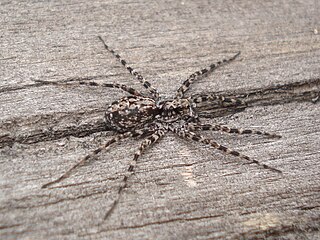 W
WAcantholycosa lignaria is a species of wolf spiders. It is a widespread species of central and northern Europe.
 W
WAelurillus v-insignitus is a species of jumping spiders.
 W
WAgelena labyrinthica is a species of spider in the family Agelenidae.
 W
WAlopecosa aculeata is a species of wolf spider in the family Lycosidae. It is found in North America, Europe, Turkey, Caucasus, a range from Russia, Central Asia, China, and Japan.
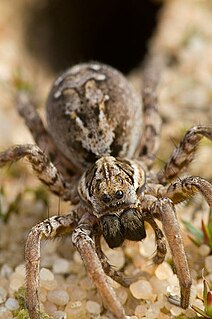 W
WAlopecosa fabrilis, known as the great fox spider, is a species of wolf spider in the family Lycosidae. It is predominately found in Europe and was rediscovered in the United Kingdom in 2020 after being thought extinct.
 W
WAlopecosa is a species of wolf spiders in the genus Alopecosa with a palearctic distribution.
 W
WAraneus angulatus is a species of orb-weaving spiders found in the Palearctic realm. It resembles the European garden spider, Araneus diadematus, but has distinctive tubercles on its abdomen. The species was first described in Aranei Svecici in 1757, where it was the first species described, making Araneus angulatus the first scientific name of an animal that is still in use.
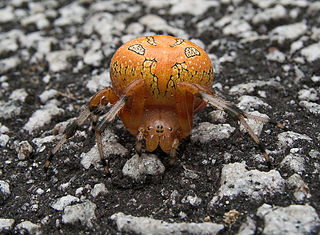 W
WAraneus marmoreus, commonly called the marbled orb-weaver, is a species of spider belonging to the family Araneidae. It is sometimes also called the pumpkin spider from the resemblance of the female's inflated abdomen to an orange pumpkin. It has a Holarctic distribution.
 W
WAraneus quadratus, the four-spot orb-weaver, is a common orb-weaver spider found in Europe and Central Asia, and as far as the Kamchatka Peninsula and Japan. Females can reach 17 mm in length, especially when gravid, males approximately half that. They are quite variable in appearance, ranging from brown to bright orange or green, but they always have the characteristic four white spots on the abdomen. The darker color morphs are easier to identify, due to the contrast between the white spots and the rest of the body. The legs are sometimes brightly striped.
 W
WAraniella cucurbitina, sometimes called the "cucumber green spider", is a spider of the family Araneidae.
 W
WClubiona pallidula is a species of sac spider in the family Clubionidae. It is found in Europe, Caucasus, a range from Russia to Central Asia, and has been introduced into North America.
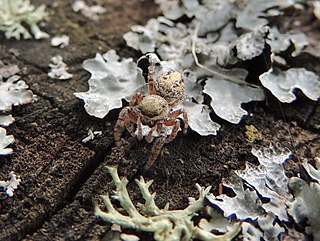 W
WDendryphantes elgonensis is a jumping spider species in the genus Dendryphantes that lives in the Palearctic.
 W
WThe raft spider, scientific name Dolomedes fimbriatus, is a large semi-aquatic spider of the family Pisauridae found throughout north-western and central Europe. It is one of only two species of the genus Dolomedes found in Europe, the other being the slightly larger Dolomedes plantarius which is endangered in the UK.
 W
WThe great raft spider or fen raft spider is a European species of spider in the family Pisauridae. Like other Dolomedes spiders, it is semiaquatic, hunting its prey on the surface of water. It occurs mainly in neutral to alkaline, unpolluted water of fens and grazing marsh.
 W
WEnoplognatha ovata is a species of spiders belonging to the family Theridiidae.
 W
WEvarcha arcuata is a species of jumping spiders with a palearctic distribution.
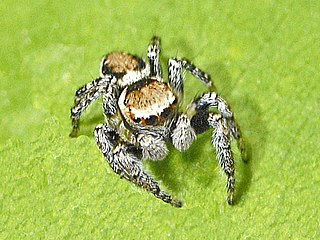 W
WEvarcha falcata is a species of 'jumping spiders' belonging to the family Salticidae.
 W
WFloronia bucculenta is a species of spiders in the family Linyphiidae. It is found in Europe and Russia.
 W
WLarinioides cornutus, the furrow spider, furrow orb spider, or foliate spider is an orb-weaver spider with Holarctic distribution.
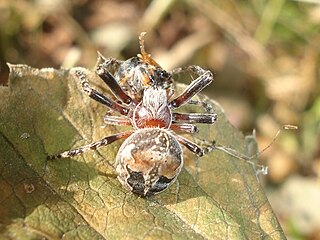 W
WLarinioides patagiatus is a species of orb weaver in the family Araneidae. It is found in North America, Europe, Turkey, Caucasus, Russia to Central Asia, China, Mongolia, and Japan.
 W
WLarinioides sclopetarius, commonly called bridge spider or gray cross spider, is a relatively large orb-weaver spider with holarctic distribution. These spiders are located in Europe and have been observed as south as the Mediterranean Coast and as North as Finland. They are often found on bridges, especially near light and over water. The species tends to live on steel objects and is seldom seen on vegetation. Females reach body length of 10–14mm, males 8–9mm. Their orb webs can have diameters of up to 70 cm.
 W
WMarpissa muscosa is a species of jumping spider.
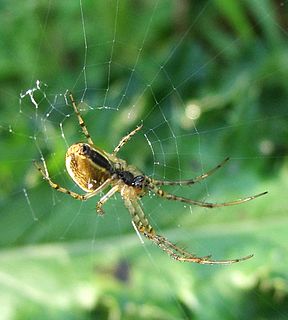 W
WMetellina segmentata is a spider in the family Tetragnathidae with a Palaearctic distribution. This spiders name is often shortened to Meta Segmentata,and some even call it Araneus segmentatus simply meaning, orb weaving spiders. It is primarily found in Europe, with the highest number in the United Kingdom, but the species has also been introduced to Canada.]
 W
WMicrommata virescens, common name green huntsman spider, is a species of huntsman spiders belonging to the family Sparassidae.
 W
WMisumena vatia is a species of crab spider with holarctic distribution. In North America, it is called the goldenrod crab spider or flower (crab) spider It is commonly found hunting in goldenrod sprays in the autumn. Males are quite small, but females can grow up to 10 mm (0.39 in) ; males reach 5 mm (0.20 in) at most. These spiders are yellow or white, and are remarkable because they have the ability to change between these two colors based on their surroundings.
 W
WNeriene montana is a species of spider belonging to the family Linyphiidae. With a holarctic distribution, it is found throughout northern Europe.
 W
WNuctenea umbratica, the walnut orb-weaver spider, is a species of spider in the family Araneidae.
 W
WPardosa amentata, otherwise known as the wolf spideror triangular is a species of spider in the genus Pardosa belonging to the family of wolf spiders, Lycosidae. The species has a widespread distribution in central Europe and northwestern Europe and are commonly found on the British Isles. The species hunts its prey on the ground rather than weaving a web.
 W
WPardosa monticola, or pin-stripe wolf spider, is a species of wolf spider found mainly in Europe. It is found in both dry and humid habitats, and up to an altitude of 2000m.
 W
WPhilodromus aureolus, the wandering crab spider, is a mainly European running crab spider of the family Philodromidae. The taxonomy of the species group named after Philodromus aureolus is in a state of flux and a number of new species have recently been recognised.
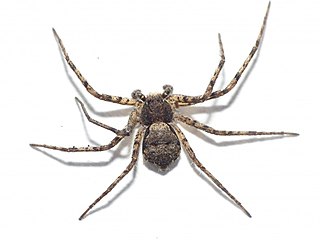 W
WPhilodromus margaritatus is a species of philodromid crab spiders. It is found in New Jersey, Europe, Turkey, Caucasus, Russia to Kazakhstan, Korea and Japan.
 W
WPhylloneta sisyphia, the mothercare spider is a species of comb-footed spider from the genus Phylloneta.
 W
WPirata piraticus is a species of wolf spider in the family Lycosidae. It is found in North America, Europe, Turkey, Caucasus, a range from Russia, Central Asia, China, and Japan.
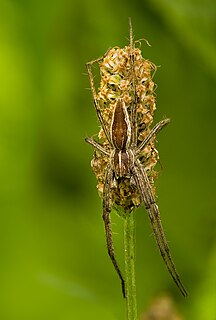 W
WThe nursery web spider Pisaura mirabilis is a spider species of the family Pisauridae.
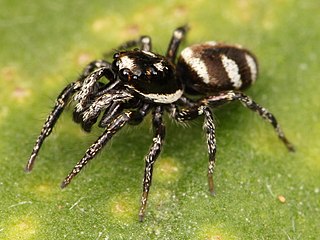 W
WThe zebra spider is a common jumping spider of the Northern Hemisphere. Like other jumping spiders it does not build a web. It has a particularly large pair of forward facing eyes that help it to locate and stalk its prey before pouncing on it. Their common name refers to their vivid black-and-white colouration, whilst their scientific name derives from Salticus from the Latin for “dancing”, in reference to their agility, and the Greek scenicus, translating to “theatrical” or “of a decorative place,” in reference to the flashy, zebra-like coloration of the species.
 W
WThe spider species Tegenaria domestica, commonly known as the barn funnel weaver in North America and the domestic house spider in Europe, is a member of the funnel-web family Agelenidae and a close relative of the hobo spider.
 W
WThanatus formicinus is a species of spider in the family Philodromidae. It has a Holarctic distribution.
 W
WXysticus cristatus, the common crab spider, is a European spider from the family Thomisidae.
 W
WZygiella x-notata, sometimes known as the missing sector orb weaver or the silver-sided sector spider, is a spider species in the family Araneidae. They are solitary spiders, residing in daily-spun orb webs. Z. x-notata are a member of the genus Zygiella, the orb-weaving spiders. The adult female is easily recognized by the characteristic leaf-like mark on her posterior opisthosoma, caudal to the yellow-brown cephalothorax.